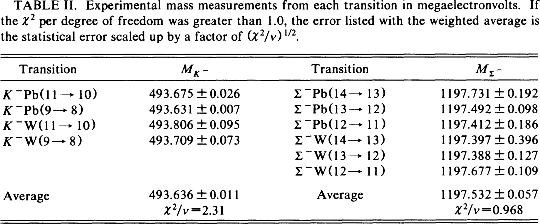If the purpose of this paper would have been just to search around
for a case of `apparent' discordant results,
as a real life example to which
apply to the model of Ref.[15] implemented in JAGS,
then
the game would be at the end. But since I am presently interested
in the charged kaon mass, I tried to understand the results a bit more.
I expected in fact to find in the publications
extensive discussions on the details of the analysis,
with explanations of what the results really meant and detailed
accounts for the sources of uncertainties, as it has presently
become a good practice by most experimental teams. But this
was not the case.
Already trying to understand the (apparently, as we shall see)
most precise value, I was quite surprised when I
realized that Ref. [9] gives no detailed information on
how they got their numbers and on what their `error' really means.
Furthermore the PDG uses an `error' of 0.007 MeV,
instead of the 0.0059 MeV reported by [9],
on the basis of a PhD thesis [10]
which it is impossible to find (not even in Russian!).
Fortunately this is more
a methodological paper then a real attempt to get a deep understanding
of the charged kaon mass, for which a throughout
analysis of all relevant published
matter on the subject would be required.21
Nevertheless, there is a point I would like to touch, related
to the second most precise result of the list [8]
whose conservative uncertainty is uncritically accepted by the PDG.
The paper provides in fact four mass values, reported for
the reader's convenience
in Fig. 12.
Figure:
Details of Ref. [8].
 |
The weighted average is
 , rescaled (and rounded)
to
, rescaled (and rounded)
to
 based on a `high
based on a `high  ', which is in reality not so bad, being
7.0 with 3 degrees of freedom,22 and thus yielding a p-value of 0.072, above even the (in-)famous
threshold of 0.05 [32].
For this reason I could not resist to make a couple of exercises:
first to see what a sceptical analysis would suggest if we stick
to the simple weighted average, without the
', which is in reality not so bad, being
7.0 with 3 degrees of freedom,22 and thus yielding a p-value of 0.072, above even the (in-)famous
threshold of 0.05 [32].
For this reason I could not resist to make a couple of exercises:
first to see what a sceptical analysis would suggest if we stick
to the simple weighted average, without the
 scaling;
second to see what we get if we make an overall sceptical analysis in
which individual results are used.
scaling;
second to see what we get if we make an overall sceptical analysis in
which individual results are used.
Subsections